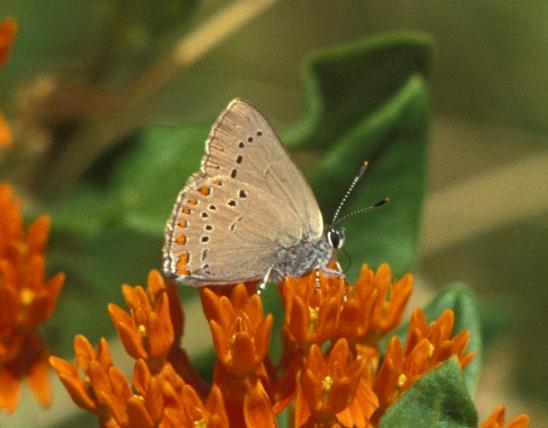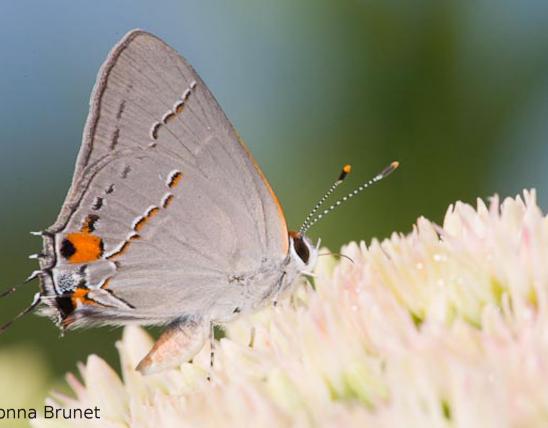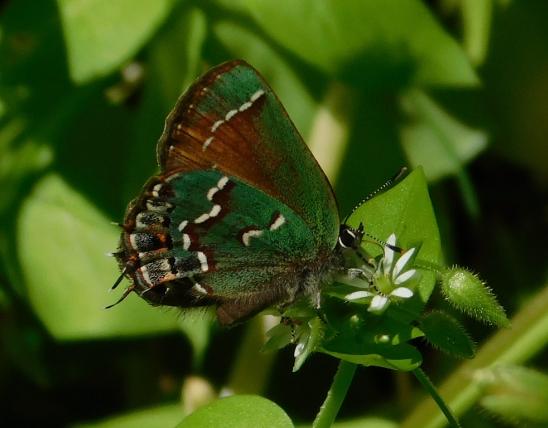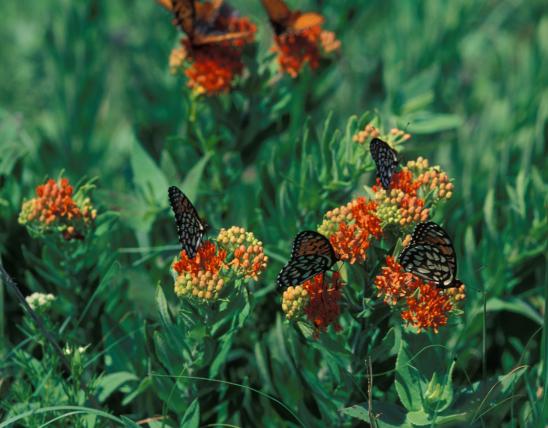
The red-banded hairstreak has a unique pattern of white, black, and red-orange bands on the underside hindwing. It is most common in the Ozarks.
Like most other hairstreaks, this species has thin banding on the otherwise plain underside and threadlike tails extending from the back edge of the hindwing. But the red-banded hairstreak’s tannish-gray underside has a unique pattern of white, black, and red-orange postmedian bands (located just outside the middle of the wing): the red-orange band is wider than the white and black bands combined, and it is positioned closer to the body than the white and black bands. The upper side is blackish brown. Females often have bright iridescent blue on the upperside hindwings, which can be glimpsed during the typical hairstreak behavior of rubbing the wings together. Springtime individuals tend to have more blue than those later in the summer, which may have none.
Larvae are drab brownish yellow-green with an indistinct bluish-green line running down the back and a heavy covering of short, brownish hairs. Reaching about ½ inch in length, they are well camouflaged within their decaying-leaf-litter habitat.
Wingspan: ¾–1 inch.
Mostly south of the Missouri River: locally common in the Ozarks; rare and sporadic in northern Missouri.
Habitat and Conservation
Found in open woodlands and edges and in brushy, second-growth fields throughout the Ozarks. Adults are most active near dusk. Males perch on the leaves of trees and shrubs, and adults are frequently seen visiting flowers and moist ground.
Food
Caterpillars mostly feed on the ground eating decaying sumac leaves (in genus Rhus, such as fragrant sumac or winged sumac), or on fallen leaves of other plants such as wax myrtle (Morella) and members of the oak and mallow families. They occasionally feed on live parts of the plant. Caterpillars have a slow growth rate feeding on detritus.
Adults visit a variety of flowers and moist places for fluids and nutrients.
Life Cycle
There are three broods in our state, and adults fly from mid-April into October. Males perch, especially in the afternoon, to await females. Females lay eggs singly on the undersides of dead leaves on the ground, near a host plant. The caterpillars hibernate.
Human Connections
In the 18th and 19th centuries, butterfly biologists plumbed Greek mythology when creating the scientific names of species. The red-banded hairstreak’s species name, cecrops, originated in ancient Greece. Cecrops was the name of a mythical king whose top half looked like a person and bottom half looked like a fish or reptile. We surmise that this name may have been chosen because this butterfly (and nearly all the other hairstreaks) appears to have two heads — a double form. (There is also a leafwing butterfly and a giant silk moth — the cecropia moth — that have the same species name.) The genus name, Calycopis, also comes from a character in Greek mythology.
Ecosystem Connections
Depending on how the group called “hairstreaks” is defined, there are some 60–80 species of hairstreaks that occur in North America north of Mexico. Hallmarks of the group include relatively bold eyespots and small, threadlike hindwing “tails.” The tails function as mock antennae to fool visual predators (such as birds and jumping spiders) into targeting the outer hindwing edge, instead of the indispensable actual head of the butterfly. Hairstreaks habitually rub the hindwings up and down, wiggling the false antennae, adding to the ruse.

































